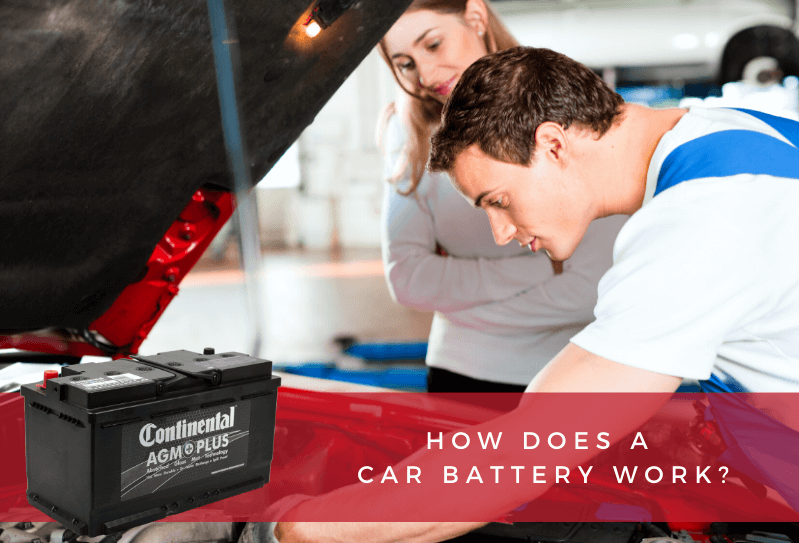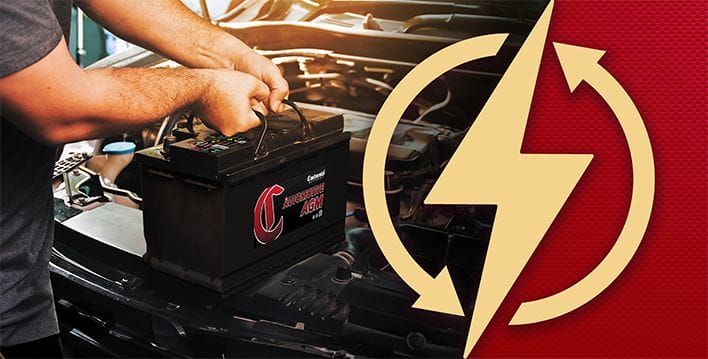
The lead-acid battery that powers most modern vehicles has been around for 150 years. The basic technology and construction have changed very little since French physicist Gaston Planté invented it in 1859.
Today’s modern car batteries power the starter motor, car radio, and everything in-between. Without it, your car is nothing more than a non-moveable hunk of plastic and metal. If you ever wondered how a car battery works, read on to learn more about how it helps keep your car running smoothly and safely.
How Does a Car Battery Work?
A car battery uses lead-acid technology to turn chemical energy into electricity. It accomplishes this through the usage of cells, which contain and store the energy until needed.
Most standard car batteries contain six cells that are situated in a row inside the plastic casing. Each cell contains a lead dioxide plate and a lead plate. Together, they create two volts for each cell—which is why it’s often referred to as a 12-volt battery.
The rows of cells are submerged in sulfuric acid, which triggers a chemical reaction between the lead dioxide and lead plates, and this creates lead sulfate and ions. As the ions move freely around the lead plates, another chemical reaction occurs, which produces hydrogen and lead sulfate.
The movement of ions generates electricity that moves to either the positive or negative terminal of the battery. The two wires that connect to your car battery then disperse the electricity to the starter motor and other vital electrical systems.
How Does the Car Battery Recharge?
A device called an alternator recharges the battery as your car drives. It generates an electrical current through an alternator belt that’s attached to the engine, which turns physical energy into electricity.
As the belt turns the alternator, it creates electricity, which is then used to power the electrical systems of the car. Some of the energy that it creates is sent back to replenish the battery. The voltage regulator is a device that helps keep the flow of electricity to optimal levels and prevents the battery from overcharging.
What Are the Different Types of Car Batteries?
Most cars on the road today have a lead-acid battery. This is the most affordable and common type on the market. The technology has been around for 150 years and has proven itself to be extremely reliable. Some cars, such as electric vehicles, use lithium-ion batteries, which have a different chemistry and a very high-performance level and capacity.
Starting Batteries – These battery types are all about cranking power and are most common in automotive and commercial fleet applications. Starting Batteries usually feature thinner but more numerous plates per cell than a deep cycle battery, giving them more surface area for more initial ‘starting’ power.
Deep Cycle Batteries – These types of batteries are most often found on golf carts and boats as they offer sustained power over an extended period of time. These batteries generally have a deeper reserve capacity that provides longer run times for many electrical vehicles or extra accessories on a vehicle. Deep cycle batteries will most often have thicker plates, which results in fewer plates per cell but more reserve capacity than a typical Starting Battery.
Wet Cell and Dry Cell (AGM) Batteries – When it comes to lead-acid car batteries, buyers have the option of choosing either a dry or wet-cell battery. While the basic operation is the same, the difference is that the dry-cell batteries have a glass mat separator, which absorbs ad suspends the electrolyte, while a wet cell submerges the plate in an electrolyte solution. The Dry Cell battery is typically sealed and non-spillable.
A Dry Cell Battery allows you to mount the battery in more places, such as the trunk, and more configurations, such as on its side. A wet-cell battery could potentially spill the electrolyte if this occurs. This greatly limits the placement and positioning of a wet cell battery, it’s safer to keep them upright under the hood of the car.
What Is Cranking Power?
The engine of your car requires physical cranking power to start. The exact amount is based upon several variables, such as engine size, temperatures, and engine type. This power is called cold-cranking amps (CCA) and is a measurement that determines the overall cranking power of the battery.
The formula for CCA is the number of amps that a 12-volt battery can produce at 0°F for 30 seconds while simultaneously keeping a 7.2 voltage. The higher the CCA rating of the battery, the better ability it has to crank the motor. This is important if you live and work in a colder climate. Generally speaking, the colder it is outside, the harder a battery has to work to deliver the power needed to crank the engine.
Continental Car Batteries
We hope this guide has helped you better understand how a battery works. At Continental Battery, we’ve been providing our customers with high-quality batteries for well over 85 years.
We’re dedicated to developing and maintaining great and long-lasting customer relationships backed up by our superior quality products. Contact us today to learn more about our company and line of car, marine, and golf cart batteries.






